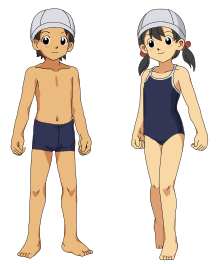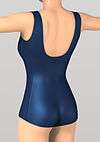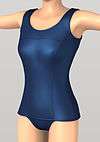Sukumizu

Sukumizu (スク水), short for school mizugi (スクール水着 sukūru mizugi, lit. "school swimsuit"), is a variant of swimwear intended for use by school students during swimming lessons in Japan. They can come in the form of either a one-piece or a two-piece swimsuit for girls, the latter of which corresponds to a sleeveless shirt for the upper torso. Boys, on the other hand, generally wear swim trunks. They are usually coloured in a dark blue hue, are closely fitting, and have typical seam lines that run laterally across the chest for girls. The material is generally a mixture of synthetic fibers such as nylon and polyester.
History
The sukumizu emerged in the late 1950s as nylon became available, which allowed for flexibility and stretchability. Until then, suits consisted mainly of cotton and acetates. With the opening of the first factories that were able to manufacture using the new material, a lucrative business was formed, and many traders formed a direct relationship with schools, in contrast with other types of garments which guaranteed a certain minimum turnover. With the expectation that there will always be new students that require new swimsuits provided by the school, garments were made from a simple-to-produce shape that has generally remained similar over time, although different types were created made from different materials.[1]
The earlier era consisted of variants which are now described as the "old type" and "old old type", which were similar to each other, and were most common during the time period from the late 1950s to the mid 1980s. Both types viewed frontally appeared to have separate top and bottom parts, although both parts were fixed together. Newer variations of the swimsuit retained the distinctive seam lines. However, they had a separation of the skirt shape and a different shape of the support, which were more attuned to the needs of the wearer.
Types
Female
Most swimsuits are one-piece suits, with distinctions between five different forms: the old type (旧タイプ kyū taipu), old old type (旧旧タイプ kyūkyū taipu), new type (新タイプ shin taipu), competition type (競泳タイプ kyōei taipu), and spats type (スパッツタイプ supattsu taipu).
Old type


The old type, also known as the "skirt form" (スカート型 sukāto-gata), is a one-piece suit with the part obscuring the pubic area connected from behind coming to the front with the surrounding fabric of the top covering the front piece seams; this results in a hole close to the belly button. The suit is sewn on the left and right sides. Due to elasticity, the body size is flexibly adapted and the inflowing of the chest can cause water leakage through the gap near the belly button, which reduces water resistance. In the region of the buttocks, there is another seam, which often has the shape of an upside-down U, which causes significant visible wrinkles in the upper part.[2] The rear shoulder area is also a U shape characterized as something resembling a deep neckline. The supports extend laterally and upwards at the shoulders, whereby a significant portion of the back is left uncovered. This gives the advantage where the length of the shoulder straps can be altered by offsetting the seams. This design was made with the assumption that students would grow in the meantime.[3]
Old old type


The old old type consisted of two garments, with the upper part resembling a skirt or a shirt, and the lower part modeled after bloomer shorts, which extends below the shoulders. Both sections are sewn on the inside, albeit not completely, so that it is possible to evert it to the level of the shoulders. To avoid accidental uncovering, the lining on the front side is connected to the lower piece. A seam at the lower end merges from the back portion directly obscuring the region surrounding the pubic area, giving a form of a skirt as seen from any direction.[2][4]
New type


Emerging around 1985, the skirt form has been removed, making the swimsuit appear more like a normal one-piece.[1] For this reason, it is also known as the "straight form" (ストレート型 straight-gata). The typical front seams were left in place, however, and the shape of the shoulder straps have been revised, which forms a Y shape on the back. This changes the direction of the tensile load, so that the shoulder straps do not slip as easily, and gives swimmers more freedom of arm movement.[3] It is made from improved stretching materials which are slightly thinner and have a smoother surface, which increases the wearer's comfort.[5]
Competition type
The competition type has its form beginning from the waist level with no longitudinal seam on the front, and is made of thinner material with smaller supports.[4]
Spats type
The spats type has great coverage of over the legs, hence its Japanese name, which refers to the English term "spats".
Male

Appearance
Colour
Sukumizu are generally supplied in a dark blue hue in the majority of cases. The dark colour prevents the swimsuit from becoming visually transparent when wet.
Nameplate
A characteristic feature of sukumizu is a name plate attached to the front of the swimsuit, placed over the chest area and allows the teacher to easily identify the students, which can be difficult due to bathing caps.
Use in media
Sukumizu is often used as a frequent theme in various Japanese media. It is often used as a running gag used for fan service or a comedic element in television series, animations and comics, and is a common ingredient in beach episodes. They are also often seen in gravure idol photoshoots and other adult entertainment media, often carrying a sexual connotation.
References
| Wikimedia Commons has media related to Sukumizu. |